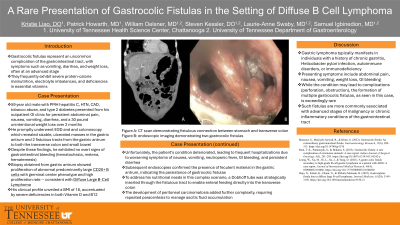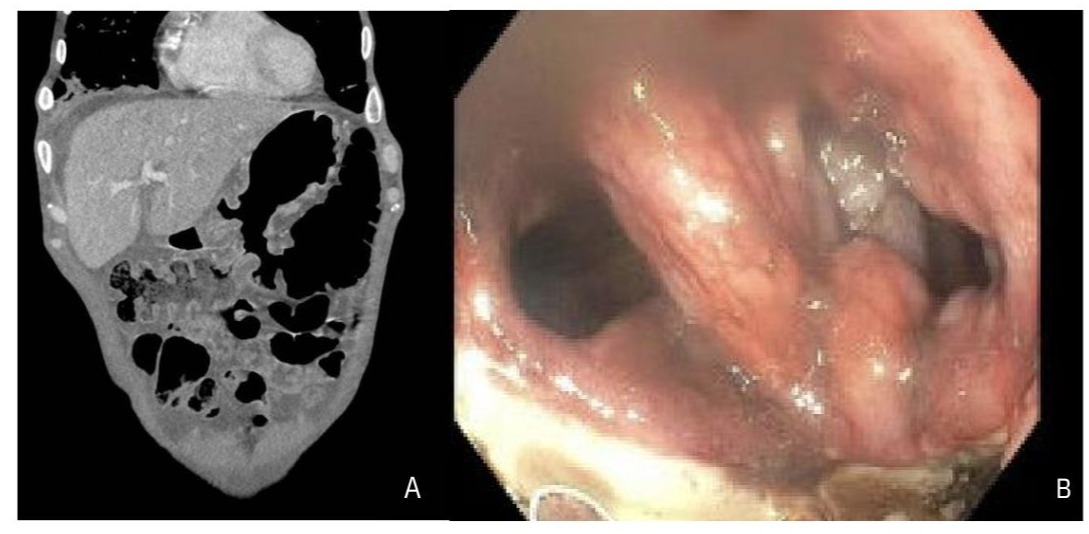Tuesday Poster Session
Category: Colon
P3786 - A Rare Presentation of Gastrocolic Fistulas in the Setting of Diffuse B Cell Lymphoma: A Case Report
Tuesday, October 29, 2024
10:30 AM - 4:00 PM ET
Location: Exhibit Hall E

Has Audio

Kristie Liao, DO
University of Tennessee Health Science Center
Chattanooga, TN
Presenting Author(s)
Kristie Liao, DO, Patrick Howarth, MD, William Oelsner, MD, Steven Kessler, DO, Laurie-Anne Swaby, MD, Samuel Igbinedion, MD
University of Tennessee Health Science Center, Chattanooga, TN
Introduction: Gastrocolic fistulas represent an uncommon complication of the gastrointestinal tract, which may manifest in both benign and malignant scenarios. Typically, patients present with symptoms such as vomiting, diarrhea, and weight loss, often at an advanced stage. Additionally, they frequently exhibit severe protein-calorie malnutrition, electrolyte imbalances, and deficiencies in essential vitamins.
Case Description/Methods: A 59 year old male with a history of hepatitis C, hypertension, CAD, tobacco abuse, and type 2 diabetes mellitus presented from his outpatient GI office for persistent abdominal pain, nausea, vomiting, diarrhea, and a 30 pound unintentional weight loss over 2 months. He underwent EGD and colonoscopy which demonstrated a sizable, ulcerated mass in the gastric antrum and two fistulous tracts to both the transverse colon and small bowel. Despite these findings, he exhibited no hematochezia, melena, or hematemesis. Biopsy obtained from the gastric antrum showed a proliferation of abnormal predominantly large CD20+ B cells with a germinal center phenotype and high proliferation rate, consistent with diffuse large B-cell lymphoma. His clinical profile unveiled a BMI of 18, accentuated by severe deficiencies in both vitamin D and B12.
Unfortunately, the patient's condition deteriorated, leading to frequent hospitalizations due to worsening symptoms of nausea, vomiting, neutropenic fever, GI bleeding, and persistent diarrhea. Subsequent endoscopies confirmed the presence of feculent material in the gastric antrum, indicating the persistence of gastrocolic fistulas. To address his nutritional needs in this complex scenario, a Dobhoff tube was strategically inserted through the fistulous tract to enable enteral feeding directly into the transverse colon. Additionally, the development of peritoneal carcinomatosis added further complexity, requiring repeated paracentesis to manage ascitic fluid accumulation.
Discussion: Gastric lymphoma typically manifests in individuals with a history of chronic gastritis, Helicobacter pylori infection, autoimmune disorders, or immunodeficiency. Presenting symptoms often include abdominal pain, nausea, vomiting, weight loss, and GI bleeding. While the condition may lead to complications such as perforation or obstruction, the formation of multiple gastrocolic fistulas, as seen in this case, is exceptionally rare. Such fistulas are more commonly associated with advanced stages of malignancy or chronic inflammatory conditions of the gastrointestinal tract.

Disclosures:
Kristie Liao, DO, Patrick Howarth, MD, William Oelsner, MD, Steven Kessler, DO, Laurie-Anne Swaby, MD, Samuel Igbinedion, MD. P3786 - A Rare Presentation of Gastrocolic Fistulas in the Setting of Diffuse B Cell Lymphoma: A Case Report, ACG 2024 Annual Scientific Meeting Abstracts. Philadelphia, PA: American College of Gastroenterology.
University of Tennessee Health Science Center, Chattanooga, TN
Introduction: Gastrocolic fistulas represent an uncommon complication of the gastrointestinal tract, which may manifest in both benign and malignant scenarios. Typically, patients present with symptoms such as vomiting, diarrhea, and weight loss, often at an advanced stage. Additionally, they frequently exhibit severe protein-calorie malnutrition, electrolyte imbalances, and deficiencies in essential vitamins.
Case Description/Methods: A 59 year old male with a history of hepatitis C, hypertension, CAD, tobacco abuse, and type 2 diabetes mellitus presented from his outpatient GI office for persistent abdominal pain, nausea, vomiting, diarrhea, and a 30 pound unintentional weight loss over 2 months. He underwent EGD and colonoscopy which demonstrated a sizable, ulcerated mass in the gastric antrum and two fistulous tracts to both the transverse colon and small bowel. Despite these findings, he exhibited no hematochezia, melena, or hematemesis. Biopsy obtained from the gastric antrum showed a proliferation of abnormal predominantly large CD20+ B cells with a germinal center phenotype and high proliferation rate, consistent with diffuse large B-cell lymphoma. His clinical profile unveiled a BMI of 18, accentuated by severe deficiencies in both vitamin D and B12.
Unfortunately, the patient's condition deteriorated, leading to frequent hospitalizations due to worsening symptoms of nausea, vomiting, neutropenic fever, GI bleeding, and persistent diarrhea. Subsequent endoscopies confirmed the presence of feculent material in the gastric antrum, indicating the persistence of gastrocolic fistulas. To address his nutritional needs in this complex scenario, a Dobhoff tube was strategically inserted through the fistulous tract to enable enteral feeding directly into the transverse colon. Additionally, the development of peritoneal carcinomatosis added further complexity, requiring repeated paracentesis to manage ascitic fluid accumulation.
Discussion: Gastric lymphoma typically manifests in individuals with a history of chronic gastritis, Helicobacter pylori infection, autoimmune disorders, or immunodeficiency. Presenting symptoms often include abdominal pain, nausea, vomiting, weight loss, and GI bleeding. While the condition may lead to complications such as perforation or obstruction, the formation of multiple gastrocolic fistulas, as seen in this case, is exceptionally rare. Such fistulas are more commonly associated with advanced stages of malignancy or chronic inflammatory conditions of the gastrointestinal tract.

Figure: A: CT scan demonstrating fistulous connection between stomach and transverse colon
B: Endoscopic imaging demonstrating two gastrocolic fistulas
B: Endoscopic imaging demonstrating two gastrocolic fistulas
Disclosures:
Kristie Liao indicated no relevant financial relationships.
Patrick Howarth indicated no relevant financial relationships.
William Oelsner indicated no relevant financial relationships.
Steven Kessler indicated no relevant financial relationships.
Laurie-Anne Swaby indicated no relevant financial relationships.
Samuel Igbinedion indicated no relevant financial relationships.
Kristie Liao, DO, Patrick Howarth, MD, William Oelsner, MD, Steven Kessler, DO, Laurie-Anne Swaby, MD, Samuel Igbinedion, MD. P3786 - A Rare Presentation of Gastrocolic Fistulas in the Setting of Diffuse B Cell Lymphoma: A Case Report, ACG 2024 Annual Scientific Meeting Abstracts. Philadelphia, PA: American College of Gastroenterology.
